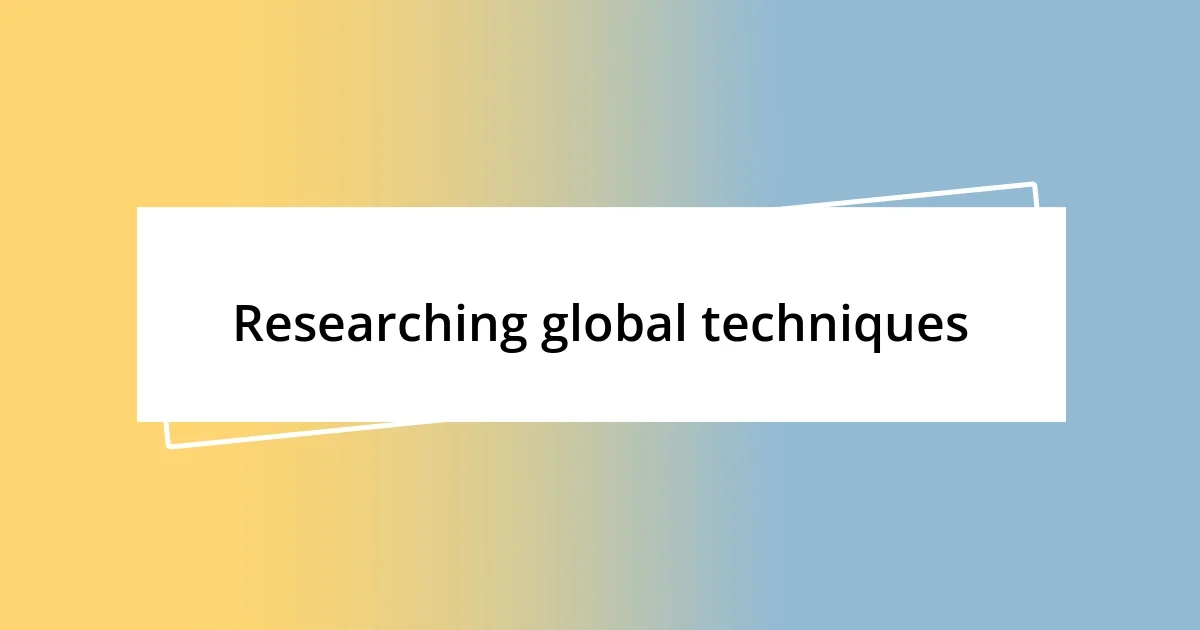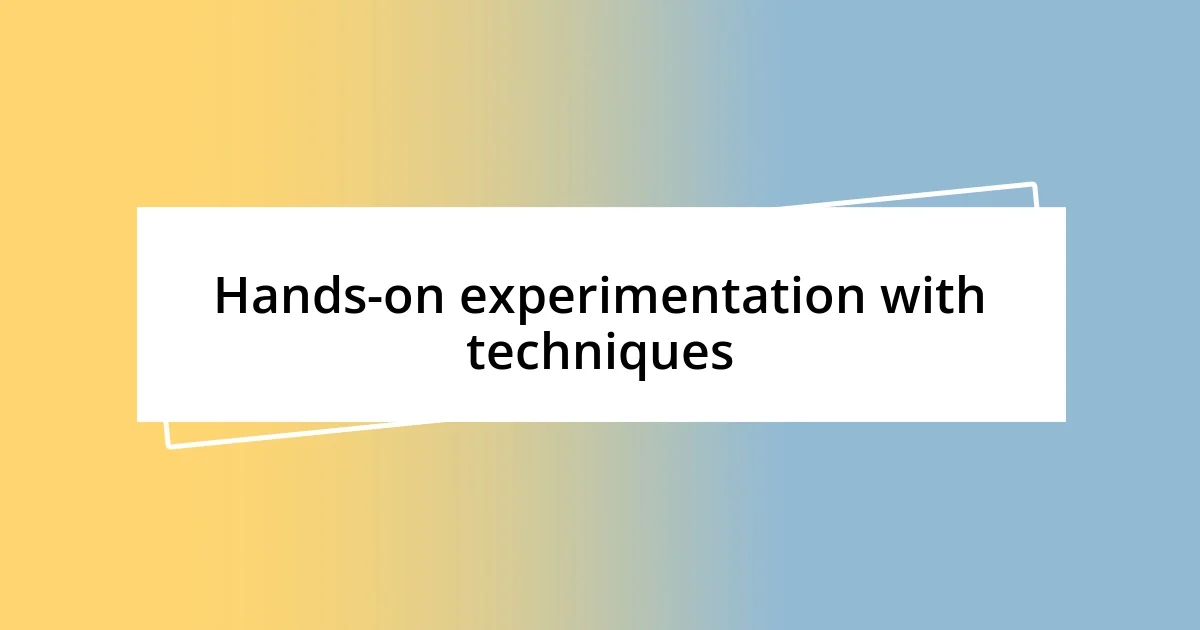Key takeaways:
- Participatory observation and comparative analysis enrich cultural understanding, revealing unique features and shared traits across traditions.
- Hands-on experimentation with techniques, such as pottery or music, fosters deeper connections to cultural practices and histories.
- Collaborating with international experts and utilizing diverse platforms facilitates knowledge exchange, leading to innovative problem-solving and shared narratives.

Understanding international exploration methods
When I think about international exploration methods, I can’t help but feel a sense of adventure. Imagine standing in a bustling market in Istanbul, observing how local historians use oral traditions to preserve their culture. This firsthand experience really opened my eyes to the diverse techniques used across nations.
One method I’ve found particularly intriguing is participatory observation, where researchers immerse themselves in the culture they’re studying. I remember attending a traditional dance festival in Mexico and feeling the rhythm in my bones. It was more than just observation; it was a vibrant connection to the community that revealed insights I could never have gathered from a textbook. Have you ever experienced something similar?
Another critical technique is comparative analysis. In my exploration, I’ve often mapped cultures against each other to highlight unique features and shared traits. For instance, looking at culinary practices in different regions, I realized how food often reflects deep historical ties and migration patterns. This method not only enriches understanding but also sparks fascinating conversations about our shared humanity. What do you think? Isn’t it amazing how exploration can reveal so much more than just facts?

Researching global techniques
Researching global techniques requires diving deep into cultural contexts. I’ve always found that engaging with local communities enhances my understanding significantly. For example, during a trip to Japan, I participated in a tea ceremony, learning not just the technique but also the philosophy behind it. This experience resonated with me on a personal level; it opened my eyes to how deeply rituals can shape a culture’s identity. Have you ever felt a similar connection while learning about another culture?
When I explore techniques across different cultures, I often compare them side by side. In one memorable instance, I analyzed protest techniques used in various countries, from peaceful demonstrations in Canada to the fervent marches in Brazil. It was fascinating to see how the socio-political landscape influenced these actions. Such comparisons not only deepen my appreciation for each technique but also illuminate the universal quest for justice and expression. Can you recall a time when you compared different approaches to a common issue?
In my research process, I’ve also utilized digital resources to broaden my scope. Online forums and global networks facilitate the exchange of ideas and experiences, allowing me to uncover lesser-known techniques. For instance, I stumbled upon an engaging discussion on how African drum circles serve as a crucial form of communal expression. This discovery reinforced the idea that even in our increasingly digital world, the essence of cultural techniques remains vibrantly alive. How do you think technology shapes our understanding of these diverse practices?
| Technique | Description |
|---|---|
| Participatory Observation | Immersing oneself in a culture for firsthand experience. |
| Comparative Analysis | Mapping and contrasting cultural techniques to reveal insights. |
| Digital Research | Utilizing online platforms for sharing and discovering techniques. |

Analyzing cultural approaches to techniques
Understanding how cultural approaches shape various techniques expands our horizons in fascinating ways. I vividly recall my time in Kerala, India, where I was captivated by Kathakali, a traditional dance-drama. The striking makeup and elaborate costumes narrate stories rooted in mythology. Experiencing a live performance felt like peeling back layers of history, immersing me in a culture where art communicates profound narratives.
When I analyze cultural techniques, I focus on the motivations that drive them. Here are some aspects that stand out to me:
- Historical Context: Understanding the historical events that shaped a technique can provide deeper insights into its importance.
- Philosophical Underpinnings: Many cultural techniques are steeped in philosophy; for example, Zen Buddhist practices highlight mindfulness and presence.
- Environmental Influence: Techniques often reflect the environment; for instance, Inuit whaling techniques are tailored to the Arctic landscape and climate.
- Communal Values: Certain techniques emphasize community bonding, like African storytelling traditions, which unite people through shared histories.
Every cultural technique conveys a story, and I aim to listen closely to those narratives. Each exploration enriches my understanding of our interconnected world—the beauty of cultural diversity continually inspires me.

Hands-on experimentation with techniques
Hands-on experimentation is where the magic truly happens for me. One memorable experience was when I got the chance to participate in a traditional pottery workshop in Mexico. As my hands shaped the clay, I could feel the history of the technique coursing through my fingertips. It made me wonder, how many generations had come before me, crafting their stories into each piece?
During my travels in Italy, I decided to try my hand at making fresh pasta. The act of kneading the dough was labor-intensive, yet therapeutic. I found that engaging in the process—not just watching—offered a deeper understanding of the culinary technique’s significance. Each twist and turn of the dough felt like a dialogue with Italian traditions. Have you ever found an unexpected joy in the simplicity of doing something yourself?
Additionally, I’ve experimented with various musical techniques, exploring instruments native to different cultures. When I picked up the djembe during a workshop in West Africa, I felt a rhythmic pulse that resonated with the community around me. The experience transformed my perception of music from merely an art form to a vehicle for connection. It’s remarkable how a hands-on approach can bridge cultural gaps, isn’t it?

Collaborating with international experts
Collaborating with international experts opens doors to a wealth of knowledge and perspectives I never knew existed. During a recent project, I teamed up with a technology specialist from Japan who introduced me to the principles of Kaizen, or continuous improvement. This shared journey highlighted how a simple change in process could lead to significant progress—it’s fascinating how such nuanced ideas can stem from different cultural backgrounds, isn’t it?
I’ve also found that these collaborations foster a profound sense of camaraderie. I remember a virtual workshop with experts from Brazil where we could brainstorm innovative solutions for sustainable farming. Our conversations were not just professional; they became a rich exchange of personal stories and cultural anecdotes. The laughter we shared as we navigated language barriers reminded me of how human connection transcends borders, creating a vibrant tapestry of ideas.
Engaging with international experts has significantly shaped my approach to problem-solving. One memorable experience involved a roundtable discussion with a data analyst from Germany. I had underestimated how different analytical methods could yield unexpected insights. Our exchanged perspectives made me realize how collaboration can spark innovation—what if this is the key to tackling challenges we haven’t yet imagined? The possibilities are truly endless.

Documenting findings and insights
Documenting findings and insights is a crucial part of my exploration process. I often keep a detailed journal during my travels, where I jot down observations about techniques I encounter. One moment that stands out was when I sketched a bamboo weaving pattern in my notebook after watching artisans in Thailand. The act of drawing not only helped me remember the process but also deepened my connection to the craft. Have you ever found that creating visuals enhances your understanding of a subject?
In addition to journaling, I love taking photographs to capture the essence of what I’ve learned. Each image tells a story, evoking emotions tied to the technique I experienced. There’s something powerful about visual representation that numbers or words alone can’t convey. For instance, the vibrant colors of spices in a market stall in India spoke volumes about the cultural significance of each ingredient. How can a single image transport us to an entirely different world?
I also leverage digital tools to organize my insights. I’ve used apps to compile videos of techniques, alongside my notes and photos, creating a multimedia archive of my experiences. This method has proved invaluable when reflecting on how different disciplines intersect. Looking back at these compilations often surprises me. What valuable connections might I have overlooked without this structured approach to documenting my journey?

Sharing knowledge through diverse platforms
Sharing knowledge has never been easier, thanks to a multitude of platforms that cater to diverse needs. Recently, I joined an online community focused on renewable energy innovations. Participating in discussions with like-minded individuals from across the globe helped me see the same problem from various angles. It’s amazing how a simple chat over a forum could lead to breakthrough ideas that I wouldn’t have considered otherwise. Have you experienced a similar moment of clarity from online interactions?
Social media platforms also play a pivotal role in knowledge exchange. I vividly recall a Twitter thread where an environmental scientist shared her findings on urban gardening techniques. Her enthusiasm was infectious, and it inspired me to experiment with growing my own herbs at home. I realized that these bite-sized nuggets of information could spark curiosity and drip-feed larger concepts that resonate with a wider audience. How many valuable lessons can we learn from the everyday posts of fellow enthusiasts?
Incorporating podcasts into my routine has enhanced my understanding of international techniques as well. Listening to experts discuss their processes while I commute feels like having a mentor in my pocket. One episode that particularly struck me involved a craftsman from Italy discussing traditional pottery styles. The way he described the connection between technique and cultural identity struck a chord with me. Isn’t it remarkable how sharing stories can weave a tapestry of collective wisdom, enriching our personal journeys?














